
| Version | Summary | Created by | Modification | Content Size | Created at | Operation |
|---|---|---|---|---|---|---|
| 1 | Amina Yu | -- | 511 | 2022-11-22 01:31:10 |
Video Upload Options
1. Introduction
Daryl Muscott Chapin[1] (21 July 1906 – 19 January 1995) was an American physicist, best known for co-inventing solar cells in 1954 during his work at Bell Labs alongside Calvin S. Fuller and Gerald Pearson. For this, he was inducted into the National Inventors Hall of Fame in 2008.
2. Biography
Chapin was born in Ellensburg, Washington (state) on 21 July 1906, although he spent his childhood in Salem, Oregon. There, he obtained his bachelor's degree from Willamette University and later on received his master's from the University of Washington. Before joining AT&T in 1930, he lectured physics at Oregon State College for a year.[2]
Prior to working on solar cells, he worked on magnetic materials. While working on power sources for remote telephone systems in humid areas such as the tropics, where dry cell batteries are unreliable, he investigated solar power as an energy source after considering alternatives like thermoelectric generators and small steam engines. Initially he investigated selenium, getting efficiencies which were too low with a yield of about 4.9 watts per square meter.[3][4][5]
At the same time, Pearson and Fuller were working on altering semiconductor properties through introduction of impurities. They created a p–n junction by dipping a gallium-doped silicon piece in lithium at around 500 °C before exposing it to sunlight, hence discovering its ability to generate photocurrents. Pearson informed Chapin of this discovery, prompting him to switch materials and after a year the functional solar cell was demonstrated on 25 April 1954.[3][6] The solar cells delivered a power of about 60 watts per square meter, for an efficiency of 6 percent, and was patented as a "solar energy converting apparatus".[7][8]
The initial discovery attracted major media attention, with the New York Times reporting the discovery on its first page as one which "may mark the beginning of a new era, leading eventually to the realization of one of mankind’s most cherished dreams–the harnessing of the almost limitless energy of the sun for the uses of civilization". It initially failed to gain major commercialization due to its still-prohibitive costs and found only niche use in small electronic devices such as the transistor radio. However, the Pentagon found use of the technology for their satellites and in 1958 launched the Vanguard 1, the first solar-powered satellite.[9]
For the discovery, Chapin was awarded an honorary doctorate by his alumni at Willamette and the John Scott Medal from Philadelphia, both in 1956. By 1959, he had simplified the solar cell's experiment to the point where it was performed by high school students across the United States . In order to bring down the cost, he experimented with polycrystalline silicon but was unable to reproduce the efficiencies of the single crystals.[10] He passed away in his home in Naples, Florida on 19 January 1995, at age 88. After his death, he was inducted into the National Inventors Hall of Fame in 2008 alongside his two co-workers.[2][11]
References
- "Obituaries from June 1995 Columns - Alumni". https://www.washington.edu/alumni/columns/june95/obits0695.html. Retrieved 28 January 2018.
- Martin, Douglas (1995). "Daryl Chapin, 88, A Co-Developer Of Solar Energy Cell". https://www.nytimes.com/1995/01/22/obituaries/daryl-chapin-88-a-co-developer-of-solar-energy-cell.html. Retrieved 27 January 2018.
- "This Month in Physics History - April 2009" (in en). https://www.aps.org/publications/apsnews/200904/physicshistory.cfm. Retrieved 27 January 2018.
- "The Invention Of The Solar Cell" (in en). https://www.popsci.com/article/science/invention-solar-cell#page-2. Retrieved 28 January 2018.
- Perlin, John (2013) (in en). Let It Shine: The 6,000-Year Story of Solar Energy. New World Library. ISBN 9781608681327. https://books.google.com/books?id=NHY7DwAAQBAJ&pg=PA478.
- Palz, Wolfgang (2010) (in en). Power for the World: The Emergence of Electricity from the Sun. Pan Stanford Publishing. p. 497. ISBN 9789814303385. https://books.google.com/books?id=sEINA3tyLUAC&pg=PA497.
- Chapin, D. M.; Fuller, C. S.; Pearson, G. L. (May 1954). "A New Silicon p-n Junction Photocell for Converting Solar Radiation into Electrical Power". Journal of Applied Physics 25 (5): 676–677. doi:10.1063/1.1721711. Bibcode: 1954JAP....25..676C. https://dx.doi.org/10.1063%2F1.1721711
- Chapin, D. M.; Fuller, C. S.; Pearson, G. L., "Solar energy converting apparatus", US patent 2780765, published 1957-02-05 http://v3.espacenet.com/textdoc?DB=EPODOC&IDX=US2780765
- Sariciftci, Niyazi Serdar (2005). Organic Photovoltaics Mechanisms, Materials, and Devices. Hoboken: CRC Press. p. 4. ISBN 9781420026351.
- Perlin, John (1999) (in en). From Space to Earth: The Story of Solar Electricity. Earthscan. pp. 166–167. ISBN 9780937948149. https://books.google.com/books?id=xHFK9cM77a8C&pg=PA166.
- "Inductee Detail - Daryl Chapin". http://www.invent.org/honor/inductees/inductee-detail/?IID=375. Retrieved 27 January 2018.

Location: Ellensburg, Washington (state) , USA




